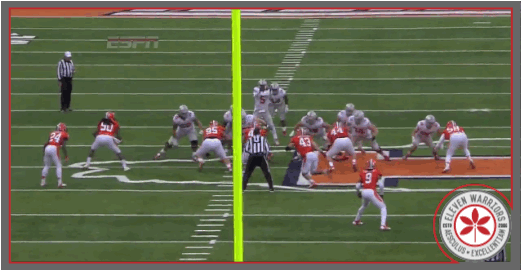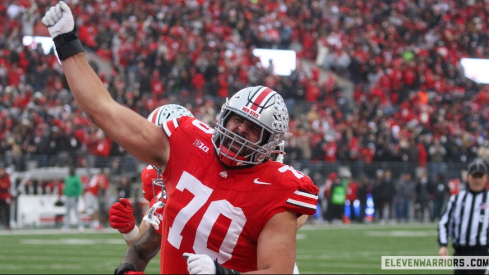Ohio State blows out Indiana, 38-15. Now, it's time to do the same to That Team Up North.

It is odd to say that the Ohio State offensive performance was inconsistent against Illinois on a day the Buckeye offense produced 51 points and over 550 yards of offense. But the prolific numbers belie that Ohio State undoubtedly had moments of sloppiness, namely to the tune of four three and outs.
The culprit was an inconsistent passing game. Urban Meyer and Tom Herman utilized the same formula that has been so successful in recent weeks, but Braxton Miller did not execute at the same level. The result was too many second and third and longs. The Buckeye offense also noticeably stalled once Left Tackle Jack Mewhort exited the game.
Despite this, the Buckeyes could and did run the ball at will with Miller and Carlos Hyde. Herman eventually turned to the run game to seal the victory, but the Buckeyes could have likely put the game away much sooner had they kept it on the ground.
Below I examine Illinois' uber-aggressive strategy, the Buckeyes' inconsistent passing game, Mewhort's absence, and the Buckeye run game.
Going for Broke
Illinois spent most plays selling out against the run. The Illini would generally line with two high safeties within ten yards, but one would come down at the snap. The Illini would use either the safety or the walked-out linebacker in the gray area to account for Miller on read plays, allowing the defensive end to crash down after Hyde.

The Illini generally played some type of single high coverage behind the front, often of the man variety. Herman also noted that Illinois responded to the Buckeyes' jet tempo with man cover 0, meaning they had no deep safety help.
WHat is it about Champaign?
Ohio State had little trouble moving the football early, combining wide receiver screens and underneath throws with Miller as a runner.
Illinois is one of the few teams that dared Miller to keep on read plays. While in theory the safety or linebacker was accounting for Miller, it did not work in practice because a) the second level defenders were held by the threat of the receiver screen game and b) Miller made guys miss even when they were in position to make a tackle. For instance, below Illinois played cover 0, allowing the outside linebacker to crash down to account for Miller. But Miller made him miss and the Illini had no one in the deep middle to make a play.

Despite the Buckeyes jumping to an early lead, the Illini were able to stick to their strategy with a significant assist from the wind. Wilth Illinois playing press coverage, Ohio State started throwing vertically. The Buckeyes repeatedly beat the Illini corners down field, but Miller struggled with distance control. As the day progressed, the wind seemed to get into his head, and his accurately deteriorated. Miller's arm angle began dropping and he was delivering the ball with too much velocity. The high incompletion rate resulted in the Buckeyes only gaining five yards per passing attempt.
The inefficiency in the passing game resulted in stalled drives. All too often the Buckeyes got themselves behind schedule, resulting in second and third and longs and reducing the opportunities to run the football.
It is difficult to criticize a strategy that has been so successful in recent weeks, that being throwing early to loosen the defense and set up the run. Moreover, like Purdue, the offensive strategy at times had the feel of as much of an attempt to work on weaknesses and put the passing game on film for future opponents, as it was trying to gain yards and score against Illinois. Meyer later conceded as much, stating that once the Buckeyes got up 28 they started "throwing it around," providing Illinois an opportunity to creep back within range.
But in so doing, the offensive staff again fell in the habit of trying to force the football down the field, on a day when the wind was not going to cooperate. The Buckeyes also inexplicably went away from the wide receiver screen game that was so effective at the outset and has been critical in recent weeks.
Ohio State still produced a lot of yards and points, but could have been even more efficient if they eschewed the deep passing game earlier. Herman later conceded that he probably underestimated the wind's impact during the game.
You Miss Him When he's Gone
It is sometimes difficult to quantify the impact of an offensive lineman. But Left Tackle Jack Mewhort's importance to the Ohio State offense was magnified in the two quarters he did not play.
Up 28-0, Meyer thought he could rest Mewhort following Mewhort hyper extending his knee in practice. But the Buckeye offense quickly began stalling without him in the game. His replacement, Daryl Baldwin, did not necessarily play poorly. But he is not Mewhort, who is one of the best tackles in the country. Furthermore, a large part of offensive line play is cohesiveness and it was clear that the line did not function at the same level without Mewhort.
The Buckeye offense was quickly jump started once he returned. After the game Meyer called Mewhort the Buckeyes' best offensive player, and it is clear what a difference Mewhort makes.
Back to Basics
After letting Illinois hang around, the Buckeye offense was able to finally pull away when Herman and Meyer consistently turned to lead plays for Miller and Hyde. In particular, the Buckeyes dealt with Illinois' safeties by using 12 personnel (1 RB, 2 TE, 2 WR) and running power. Second tight end Nick Vannett kicked out the defensive end, the guard sealed the play side linebacker, and Hyde was able to bounce the play outside to the second level.

The use of 2-back power negated Illinois' additional box defender and strategy of crashing the backside defensive end on inside zone.
Hyde again demonstrated that he is playing at as high a level as any running back in the country. He benefits from the fact the offensive line generally gets him past the line of scrimmage untouched, but that only makes Hyde more dangerous. He demonstrates great vision once he gets to the second level and finishes runs violently, making him very difficult to tackle by the first defender. Playing at 230 pounds has also provided Hyde the acceleration necessary to create explosive plays. In fact, the key to the Buckeye point total was eight explosive rushing plays.
Illinois' man coverage defense also allowed Miller to run with impunity. Below, the Buckeyes ran a simple inside zone but the Illini cover 0 provided no one to account for Miller.

Games such as this are somewhat of a no-win situation for Ohio State. The coaching staff likely knows that they could line up, run Hyde and Miller 20 times each and win handily. Illinois adopted the strategy of certain other underdogs against Ohio State and assumed Meyer and Herman would generally not run Miller in an attempt to save him, allowing them to employ risky strategies such as cover 0. But running Miller frequently does not necessarily help the Buckeyes improve and set up future opponents. At the same time, they are now in an almost unwinnable weekly perception battle.
In hindsight, the Buckeyes likely tried to throw vertically more often than was warranted, given the weather conditions. But the step back in the passing game was likely more of a blip than a trend. Meyer and Herman know that the inside run game is the Buckeyes' bread and butter. But they want to work the pass game in such situations to improve and force future opponents to think twice before selling out against the run, and ensure that the Buckeyes' constraint plays are functioning well when defenses do adopt such strategies.

